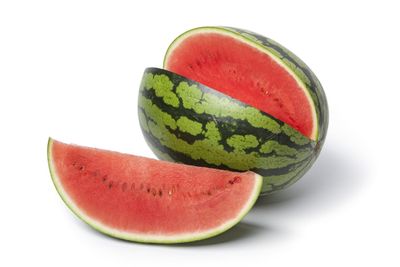What is a Crimson Sweet Watermelon?
Who doesn’t like fresh, juicy watermelon? Growing your own means you have fresh fruit at hand whenever you crave the melon’s sweet flavor. Bright red and firmly fleshed, Crimson Sweet in gardens require room to sprawl but bring a taste of summer to your table fresh from the melon patch. Some tips on how to grow Crimson Sweet watermelons will have your family enjoying them within 80 days in proper growing conditions. This variety was introduced by Kansas State University in 1963 and has become a commercial favorite which ships and stores well. Crimson Sweet develops large 15 to 25 pound (7-11 kg.) fruits with lovely dark and light green striping and deeply red flesh. The melons are oval with blunt ends and ripen just as the summer heat is beginning to sizzle. The vines are 6 to 8 feet (about 2 m.), sprawling and rambling over anything in their path. The melons are resistant to fusarium wilt and anthracnose, two common fungal diseases of the garden that do not have a cure. These traits and others make Crimson Sweet watermelon care a much more breezy affair than varieties without resistance.
How to Grow Crimson Sweet Watermelons
Select a bright, sunny location for growing Crimson Sweet watermelons. Watermelons grow well on hills which offer warmer soil, deeper root space, and irrigation opportunities that keep moisture off the leaves. Work soil at the sight deeply and incorporate plenty of organic matter. In short season zones, start seeds indoors three to four weeks before the last expected frost. Install the plants 2 to 3 feet apart (61-91 cm.) in rows spaced 6 to 8 feet (about 2 m.). If transplanting indoor starts, harden them off for a week before planting in the bed. Side dress with compost. In northern gardens, use row covers early in the season to help keep temperatures warm, but remove them when flowers begin to appear.
Crimson Sweet Watermelon Care
Use soaker hoses around the mounds to water roots and avoid moisture on the leaves which can cause a variety of fungal diseases. Keep plants consistently moist until fruits begin to appear. Then water only when soil is dry and reduce watering as fruits begin to ripen to concentrate sugar in the melons. Row covers or pyrethrin based insecticides will protect the plants from many flying insect pests. Harvest fruits when the rind changes from bright to dull green. Rap on fruits to check for a low-pitched tone. The fruit will keep two or three weeks unrefrigerated but will last longer in a cool place such as the basement.
